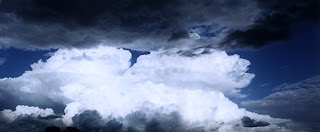
This past week the rain had really came down along with lightning and thunder on some days... Ever wondered what's really going on when you see lightning and then several seconds later boom! Crackle! you hear thunder? Most people would say "It's a thunder storm!" but actually what I have found out is that lightning is the cause of thunder!! So actually it should be called a "Lightning and Thunder Storm" instead of thunder and lightning or just a thunder storm.
Now, the question what causes a so called "thunderstorm"? What's happening with all the lightning and thunder going on? What causes lightning... what causes thunder? This is good to know as future teachers... and could be used in a lesson!
Starting with... What's lightning and what causes it?

A little more sophisticated and detailed insight... inside a thunderstorm, electric charge is spread out differently. A thunderstorm consists of ice crystals and hailstones. The ice crystals have a positive charge, while the hailstones have a negative charge. The positively charged ice crystals are pushed to the top of the thunderstorm cloud by an updraft. Meanwhile, the heavy negatively charged hailstones are pushed to the bottom of the thunderstorm by its downdraft. Thus, the thunderstorm's positive and negative charges are separated into two levels: the positive charge at the top and the negative charge at the bottom.
During a thunderstorm, the Earth's surface has a net positive charge. Because opposites attract, the negative charge at the bottom of the thunder cloud wants to link up with the positive charge of the Earth's surface.
Once the negative charge at the bottom of the cloud gets large enough to overcome air resistance, a flow of negative charge rushes toward the earth. This is known as a "stepped leader". The positive charges of the Earth are attracted to this stepped leader, so a flow of positive charge moves up through some elevated point, such as a tree or a telephone pole, and into the air. When the stepped leader and the positive charge from the earth meet, a strong electric current carries positive charge up into the cloud. This electric current is known as the return stroke of lightning and is visible to the human eye. The above process will occur three or four times, all within a few seconds. Normally the human eye cannot distinguish between all of the return strokes. Wow! How exciting that all of this is going on!... Along with all that info there are different types (an easy to read website) of lightning, the ones we can see and cannot see.
resistance, a flow of negative charge rushes toward the earth. This is known as a "stepped leader". The positive charges of the Earth are attracted to this stepped leader, so a flow of positive charge moves up through some elevated point, such as a tree or a telephone pole, and into the air. When the stepped leader and the positive charge from the earth meet, a strong electric current carries positive charge up into the cloud. This electric current is known as the return stroke of lightning and is visible to the human eye. The above process will occur three or four times, all within a few seconds. Normally the human eye cannot distinguish between all of the return strokes. Wow! How exciting that all of this is going on!... Along with all that info there are different types (an easy to read website) of lightning, the ones we can see and cannot see.What's thunder and what causes it?
Thunder is basically the big boom, rumble, crackle!! that you hear in the clouds! Along with following lightning... It's the extreme hot heat that lightning gives off mixing with the cold air that are in the clouds.

A little more technical info on thunder is like I mentioned before lightning bolts are extremely hot, with temperatures of 30,000 to 50,000 degrees F. That's hotter than the surface of the sun! When the bolt suddenly heats the air around it to such an extreme, the air instantly expands, sending out a vibration or shock wave we hear as an explosion of sound. This is thunder. If you are near the stroke of lightning you’ll hear thunder as one sharp crack. When lightning is far away, thunder sounds more like a low rumble as the sound waves reflect and echo off hillsides, buildings and trees. Depending on wind direction and temperature, you may hear thunder for up to fifteen or twenty miles.
So now you know what's happening when you see lightning and hear thunder.... but why is it that they don't hit at the same time? Well, of course light travels up to five times faster than sound that's why there is a delay in the sound of thunder after you see lightning hit. Even sometimes you may not see lightning taking place because it's the type of lightning that happens from cloud to cloud (if you checked out that website above you would know what I'm talking about) you'll still be able to hear the thunder (even the ones that are not that loud).



















